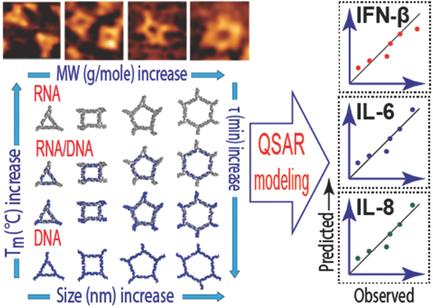Our official English website, www.x-mol.net, welcomes your
feedback! (Note: you will need to create a separate account there.)
Programmable Nucleic Acid Based Polygons with Controlled Neuroimmunomodulatory Properties for Predictive QSAR Modeling.
Small ( IF 13.0 ) Pub Date : 2017-09-18 , DOI: 10.1002/smll.201701255 Morgan Brittany Johnson 1 , Justin R Halman 2 , Emily Satterwhite 2 , Alexey V Zakharov 3 , My N Bui 4 , Kheiria Benkato 4 , Victoria Goldsworthy 4 , Taejin Kim 5 , Enping Hong 6 , Marina A Dobrovolskaia 6 , Emil F Khisamutdinov 4 , Ian Marriott 1 , Kirill A Afonin 2, 7
Small ( IF 13.0 ) Pub Date : 2017-09-18 , DOI: 10.1002/smll.201701255 Morgan Brittany Johnson 1 , Justin R Halman 2 , Emily Satterwhite 2 , Alexey V Zakharov 3 , My N Bui 4 , Kheiria Benkato 4 , Victoria Goldsworthy 4 , Taejin Kim 5 , Enping Hong 6 , Marina A Dobrovolskaia 6 , Emil F Khisamutdinov 4 , Ian Marriott 1 , Kirill A Afonin 2, 7
Affiliation

|
In the past few years, the study of therapeutic RNA nanotechnology has expanded tremendously to encompass a large group of interdisciplinary sciences. It is now evident that rationally designed programmable RNA nanostructures offer unique advantages in addressing contemporary therapeutic challenges such as distinguishing target cell types and ameliorating disease. However, to maximize the therapeutic benefit of these nanostructures, it is essential to understand the immunostimulatory aptitude of such tools and identify potential complications. This paper presents a set of 16 nanoparticle platforms that are highly configurable. These novel nucleic acid based polygonal platforms are programmed for controllable self-assembly from RNA and/or DNA strands via canonical Watson-Crick interactions. It is demonstrated that the immunostimulatory properties of these particular designs can be tuned to elicit the desired immune response or lack thereof. To advance the current understanding of the nanoparticle properties that contribute to the observed immunomodulatory activity and establish corresponding designing principles, quantitative structure-activity relationship modeling is conducted. The results demonstrate that molecular weight, together with melting temperature and half-life, strongly predicts the observed immunomodulatory activity. This framework provides the fundamental guidelines necessary for the development of a new library of nanoparticles with predictable immunomodulatory activity.
中文翻译:

具有受控神经免疫调节特性的基于可编程核酸的多边形,用于预测 QSAR 建模。
在过去的几年中,治疗性 RNA 纳米技术的研究已经极大扩展,涵盖了一大批跨学科科学。现在很明显,合理设计的可编程RNA纳米结构在应对当代治疗挑战(例如区分靶细胞类型和改善疾病)方面具有独特的优势。然而,为了最大限度地发挥这些纳米结构的治疗效果,必须了解此类工具的免疫刺激能力并识别潜在的并发症。本文提出了一组高度可配置的 16 个纳米颗粒平台。这些基于核酸的新型多边形平台经过编程,可通过典型的 Watson-Crick 相互作用从 RNA 和/或 DNA 链进行可控自组装。事实证明,可以调整这些特定设计的免疫刺激特性以引发所需的免疫反应或缺乏免疫反应。为了促进目前对有助于观察到的免疫调节活性的纳米颗粒特性的理解并建立相应的设计原则,进行了定量结构-活性关系建模。结果表明,分子量以及解链温度和半衰期可以强烈预测观察到的免疫调节活性。该框架为开发具有可预测免疫调节活性的新纳米粒子库提供了必要的基本指导。
更新日期:2017-09-18
中文翻译:

具有受控神经免疫调节特性的基于可编程核酸的多边形,用于预测 QSAR 建模。
在过去的几年中,治疗性 RNA 纳米技术的研究已经极大扩展,涵盖了一大批跨学科科学。现在很明显,合理设计的可编程RNA纳米结构在应对当代治疗挑战(例如区分靶细胞类型和改善疾病)方面具有独特的优势。然而,为了最大限度地发挥这些纳米结构的治疗效果,必须了解此类工具的免疫刺激能力并识别潜在的并发症。本文提出了一组高度可配置的 16 个纳米颗粒平台。这些基于核酸的新型多边形平台经过编程,可通过典型的 Watson-Crick 相互作用从 RNA 和/或 DNA 链进行可控自组装。事实证明,可以调整这些特定设计的免疫刺激特性以引发所需的免疫反应或缺乏免疫反应。为了促进目前对有助于观察到的免疫调节活性的纳米颗粒特性的理解并建立相应的设计原则,进行了定量结构-活性关系建模。结果表明,分子量以及解链温度和半衰期可以强烈预测观察到的免疫调节活性。该框架为开发具有可预测免疫调节活性的新纳米粒子库提供了必要的基本指导。











































 京公网安备 11010802027423号
京公网安备 11010802027423号